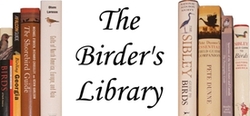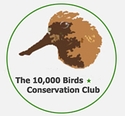September 24th, 2010
hover-glean: when prey is gleaned from a surface while the foraging bird is airborne
A Field Guide to Warblers of North America
I’ve been trying my hand at bird photography recently, and I’ve learned one major thing – it’s hard. Somehow, I don’t think that will come as a revelation to anyone. Many of the pictures I’ve taken are, at the very least, identifiable as to what species it depicts. But sharp focus is still a very elusive prey. And I still don’t know enough about the camera and photographic principles to make needed adjustments to the settings.
But even so, you can still get lucky sometimes. I was trying to capture a Magnolia Warbler at the end of a branch, when it started hover-gleaning. I was actually able to get several pictures in-flight, and even though they aren’t in perfect focus, I think they’re my favorite shots to date.
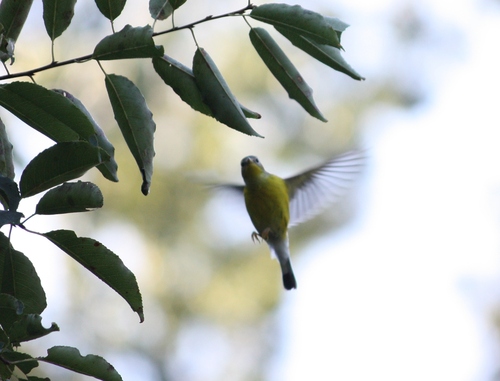
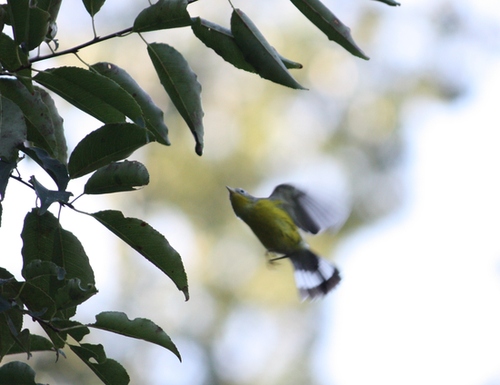
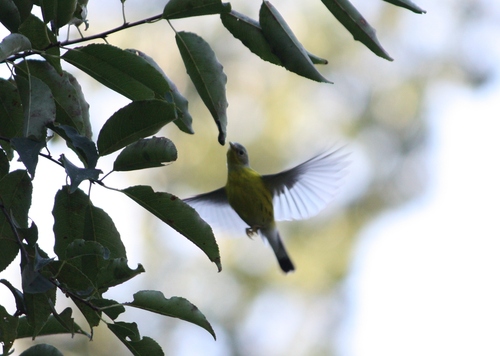
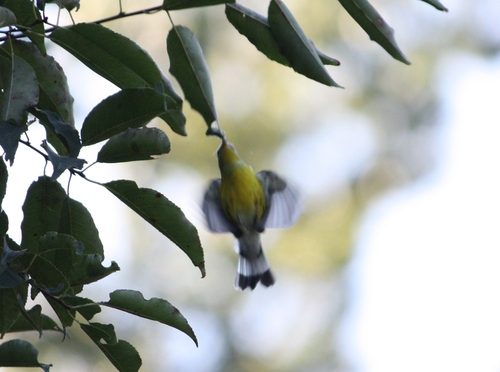
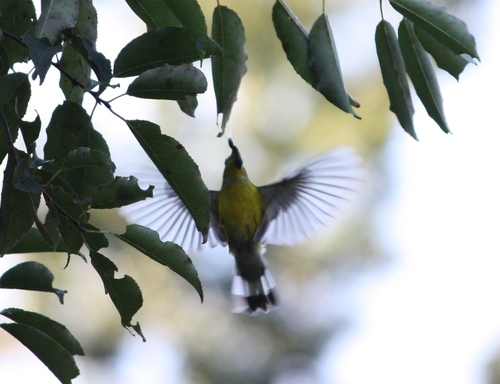
The funny thing is that I had no idea the warbler actually nabbed something until I was reviewing the pictures!
Tags:
bird behavior,
warblers
 Posted in Birds |
Posted in Birds |  11 Comments »
11 Comments »
September 20th, 2010
When I bird my “local patch” – my neighborhood’s preserve – I rarely have a specific target in mind. You just never know what’s going to be there. But today was different. I really wanted to see a Philadelphia Vireo.
I just love that adorable, little bird. That admission may cost me some birder points, or some such, but I stand by it. And I don’t get to see them very often. They come through Georgia, or at least my little part, the last ten or so days each September. I’ve seen at least one here each of the last four years, with the exception of the last (I was a little distracted by the birth of my first child, but that’s ok, she’s even more adorable than Philly Vireos).
So it wasn’t much of a stretch to wish for a Philly today. But it didn’t start out very promising. Most of my vireo sightings have been in the clearing around a small observation deck in the middle of the preserve. (I have no idea why it’s there; it’s not really overlooking anything. But I see a lot of birds from it, so I’m not complaining.) But when I got to the deck this morning, there was nothing around except for a couple of Ruby-throated Hummingbirds that have been fighting over a patch of jewelweed. So I waited. Eventually, a Red-eyed Vireo popped up, but that was about it.
I was just about to leave when I thought, “I just want to see a Philadelphia Vireo”. The exact moment after that plea went through my mind, I spotted this little guy.
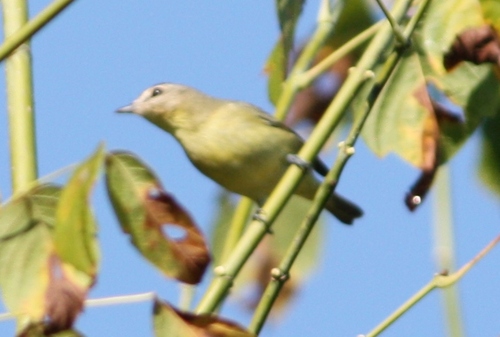
Two Philadelphia Vireos had materialized in the willows. They foraged around the clearing for a couple of minutes, and then disappeared as suddenly as they appeared.
You can choose to believe that this was just a case of a birder knowing exactly when and where a particular species was likely to show up. But me? I’m wondering if this isn’t some sort of latent birding superpower. I guess I’ll find out tomorrow – I’m going to be thinking about how much I want to see a Mourning Warbler.
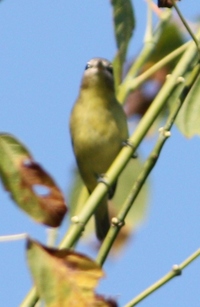
You summoned?
Tags:
neighborhood preserve,
vireos
 Posted in Georgia |
Posted in Georgia |  3 Comments »
3 Comments »
September 17th, 2010
One of the things I love most about birding is all of the books that go along with it. There are field guides, of course, but also guides to finding birds as well as ones for specific groups of birds. Travelogues take the reader to places they may never get to bird themselves, while other books explore the very nature of birding itself. The list goes on, and I love them all.
For this edition of I and the Bird, I’d like to explore some of the books that make up a birder’s library and show how they can be useful.
Before we start, I’d like to point out that the book links will direct you to my review of that title at The Birder’s Library, if I’ve done one. Otherwise, they will be Amazon affiliate links. If you purchase something after clicking on an affiliate link, I’ll get a small percentage, which I use to pay web hosting costs and, if I’m lucky, buy even more books to review. I’m not doing this to make money; I just think it’s a good way to raise awareness for some wonderful books and provide more information about them.
 The field guide is the cornerstone of any birding library. I really should say field guides, because you need more than one for your area. They all have particular strengths and weaknesses, but when they are used in conjunction you have a much better chance at making a positive identification. Some guides utilize paintings as illustrations while others use photographs. I’d recommend having at least one of each. It’s also a good idea to have a guide that includes all the likely (and not-so-likely) vagrants, like a Cuban Pewee in Florida.
The field guide is the cornerstone of any birding library. I really should say field guides, because you need more than one for your area. They all have particular strengths and weaknesses, but when they are used in conjunction you have a much better chance at making a positive identification. Some guides utilize paintings as illustrations while others use photographs. I’d recommend having at least one of each. It’s also a good idea to have a guide that includes all the likely (and not-so-likely) vagrants, like a Cuban Pewee in Florida.
 But not even the most thorough field guide will include every bird that you could possibly see. You just never know what might show up. Thus, it’s a good idea for birders to also have field guides for other areas, especially those relatively nearby. Birders in the Southeast United States, for example, should have a guide to Caribbean birds handy, such as the new Birds of the West Indies.
But not even the most thorough field guide will include every bird that you could possibly see. You just never know what might show up. Thus, it’s a good idea for birders to also have field guides for other areas, especially those relatively nearby. Birders in the Southeast United States, for example, should have a guide to Caribbean birds handy, such as the new Birds of the West Indies.
 Although a field guide’s primary purpose is to present information needed for identification, some of them also provide other natural history facts, like the graphs in Birds of Australia that indicate when each species breeds. That’s nice to know, as pelicans breeding on Lake Wyara is quite a sight.
Although a field guide’s primary purpose is to present information needed for identification, some of them also provide other natural history facts, like the graphs in Birds of Australia that indicate when each species breeds. That’s nice to know, as pelicans breeding on Lake Wyara is quite a sight. The majority of field guides in a birder’s library will be for, duh, birds. But that doesn’t mean we should ignore other organisms. A more general field guide could certainly be useful while on a beach in Costa Rica with birds, monkeys, and snakes.
The majority of field guides in a birder’s library will be for, duh, birds. But that doesn’t mean we should ignore other organisms. A more general field guide could certainly be useful while on a beach in Costa Rica with birds, monkeys, and snakes.
 Some birds – immature hawks, for instance – can be very difficult to ID, and sometimes you need more help than a general field guide can provide. Thankfully, there are several advanced birding guides that focus especially on these birds.
Some birds – immature hawks, for instance – can be very difficult to ID, and sometimes you need more help than a general field guide can provide. Thankfully, there are several advanced birding guides that focus especially on these birds. Sometimes you need something even more detailed and specific than advanced ID guides. There are certain groups of birds, like seabirds, that almost require a family-specific guide. Such a book would definitely be nice to have on a pelagic trip off of Panama.
Sometimes you need something even more detailed and specific than advanced ID guides. There are certain groups of birds, like seabirds, that almost require a family-specific guide. Such a book would definitely be nice to have on a pelagic trip off of Panama.
 Family guides aren’t useful solely for identification; they can also be great sources on the biology and behavior of the group. If, for instance, you would like to see raptors in Costa Rica, it would be helpful to find out beforehand that most hawks there aren’t likely to be seen soaring, but rather inconspicuously perched.
Family guides aren’t useful solely for identification; they can also be great sources on the biology and behavior of the group. If, for instance, you would like to see raptors in Costa Rica, it would be helpful to find out beforehand that most hawks there aren’t likely to be seen soaring, but rather inconspicuously perched.
 Similarly, if you encounter something unusual, like bald mynas, a family guide may be able to help explain it (although in this case it didn’t, Starlings and Mynas didn’t shed any light on this situation, unfortunately).
Similarly, if you encounter something unusual, like bald mynas, a family guide may be able to help explain it (although in this case it didn’t, Starlings and Mynas didn’t shed any light on this situation, unfortunately).
 Besides their myriad of uses, it can be a great pleasure just to flip through field and family guides. You can discover all kinds of interesting and cool-looking birds that way, such as one of my favorite groups – nightjars.
Besides their myriad of uses, it can be a great pleasure just to flip through field and family guides. You can discover all kinds of interesting and cool-looking birds that way, such as one of my favorite groups – nightjars.
 After a field guide, the first bird book I bought was a birdfinding guide for my state. After all, you need to know where the birds are in order to watch them! Even with the abundance of information now available online, a good birdfinding guide is still indispensible, and will point you toward some great birdwatching locations, like Charlie Elliott Wildlife Center in Georgia and California’s Vic Fazio Yolo Wildlife Area.
After a field guide, the first bird book I bought was a birdfinding guide for my state. After all, you need to know where the birds are in order to watch them! Even with the abundance of information now available online, a good birdfinding guide is still indispensible, and will point you toward some great birdwatching locations, like Charlie Elliott Wildlife Center in Georgia and California’s Vic Fazio Yolo Wildlife Area. For some people, birding is more than just a hobby. Reference books and those that synthesize research on specific topics can by handy when doing field work and pursuing a degree.
For some people, birding is more than just a hobby. Reference books and those that synthesize research on specific topics can by handy when doing field work and pursuing a degree. Birds do some weird things. A well-stocked library can help explain some of them, like why 38,000 puffins would want to live together.
Birds do some weird things. A well-stocked library can help explain some of them, like why 38,000 puffins would want to live together.
 Learning about birds’ needs and habits during migration can help you find migrants and get some pictures of them.
Learning about birds’ needs and habits during migration can help you find migrants and get some pictures of them.
 Would you like to attract more birds to your yard? There are plenty of books that will help you landscape for birds, even hummingbirds in Texas.
Would you like to attract more birds to your yard? There are plenty of books that will help you landscape for birds, even hummingbirds in Texas.
 Ever wonder what it’s like to hear like a bird? We’ll never know for sure, but The Singing Life of Birds will definitely help you better understand bird sounds.
Ever wonder what it’s like to hear like a bird? We’ll never know for sure, but The Singing Life of Birds will definitely help you better understand bird sounds.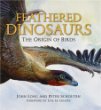
 Bird books can provide insight not only into what birds are and how they live, but also into where they came from. Perhaps a comparison between a heron and dinosaurs isn’t that much of a stretch.
Bird books can provide insight not only into what birds are and how they live, but also into where they came from. Perhaps a comparison between a heron and dinosaurs isn’t that much of a stretch. I love getting new field guides, discovering how birds fly, and exulting in a collection of fantastic bird photography. But perhaps more than any other kind of bird book, I enjoy those that explore what it means to be a birder.
I love getting new field guides, discovering how birds fly, and exulting in a collection of fantastic bird photography. But perhaps more than any other kind of bird book, I enjoy those that explore what it means to be a birder. Finally, not every item in a birder’s library need be a book. If it hasn’t already, software and other media is going to make a big impact in how we bird, even keeping track of the birds we observe.
Finally, not every item in a birder’s library need be a book. If it hasn’t already, software and other media is going to make a big impact in how we bird, even keeping track of the birds we observe.
As you can see, the books in your birding library can provide a wealth of information and hours (or even years in extreme cases) of entertainment. But there comes a point, even for me, when you just need to put down the book and go birding.
I hope you enjoyed this trip through a birder’s library as much as I enjoyed everyone’s submissions. The next edition of I and the Bird will be hosted on The Birder’s Report. In the meantime, if you’d like to find out more about the books I’ve mentioned or similar ones, or would like to suggest others, please let me know. I think it’s obvious that I love to discuss bird books.
Tags:
books
 Posted in I and the Bird |
Posted in I and the Bird |  18 Comments »
18 Comments »
September 14th, 2010
Until this last week, I haven’t birded much recently. It’s been hard to get out since there’s a baby girl at home who likes to spend time with her daddy. And who can say no to that? But if I’m honest with myself, it’s also been tough to find motivation to get out. Summer is hot (and unbearably muggy here in the South) and there aren’t that many birds out.
Thank goodness for fall and migration! The chance of seeing different birds is a good motivation. But since I still have the time constraints to deal with, I mostly bird close to home. So I’m really fortunate that our neighborhood has its own nature preserve.
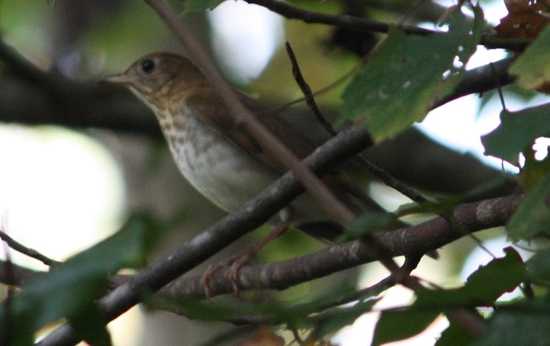
Gray-cheeked Thrush at my neighborhood preserve
It’s very nice, yes, but it’s definitely not what you would call a birding hotspot. It’s small, about 10 acres, but with fairly nice habitat. I’ve birded it five times in the last week, for about an hour each morning, and have only averaged 25 species a day. So the diversity isn’t all that great on any given visit. But, on the bright side, there’s usually something new every day. One day it’s a Yellow-breasted Chat, the next a Worm-eating Warbler.
A single morning at a true migration hotspot would probably yield more species than I get here all season. But still, it’s great to have a place so close by where I can loose myself amongst the birds for an hour or so. And, if nothing else, it appears that my birding slump is over.
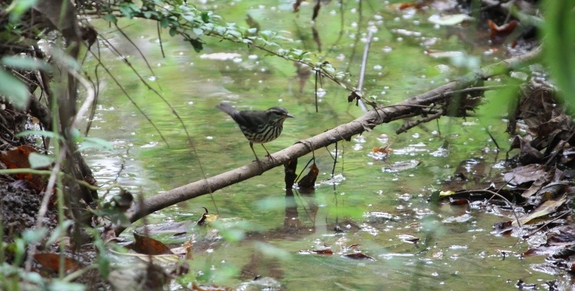
Northern Waterthrushes are very common here in migration
Tags:
neighborhood preserve
 Posted in Georgia |
Posted in Georgia |  3 Comments »
3 Comments »
September 7th, 2010
I’m honored that the next edition (the 134th!) of I and the Bird is coming here. I and the Bird is a biweekly blog carnival showcasing bird writing on the net.
If you have a blog and would like to have one of your posts included, please email me.
 Posted in I and the Bird |
Posted in I and the Bird |  No Comments »
No Comments »





 Posted in
Posted in 























